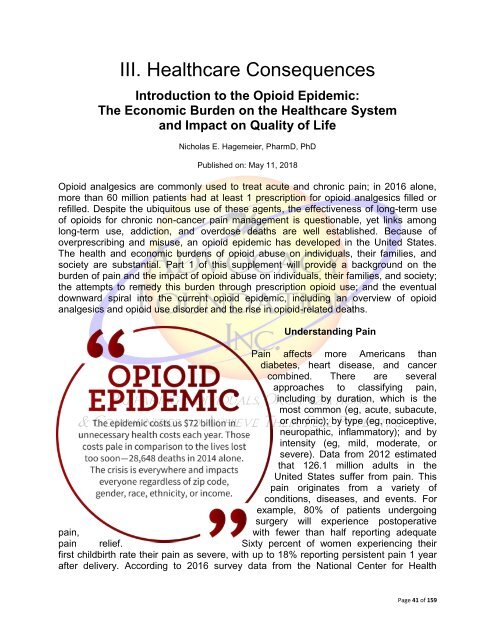The Economic Consequences of Opioid Addiction in America
The Economic Consequences of Opioid Addiction in America
The Economic Consequences of Opioid Addiction in America
Create successful ePaper yourself
Turn your PDF publications into a flip-book with our unique Google optimized e-Paper software.
III. Healthcare <strong>Consequences</strong><br />
Introduction to the <strong>Opioid</strong> Epidemic:<br />
<strong>The</strong> <strong>Economic</strong> Burden on the Healthcare System<br />
and Impact on Quality <strong>of</strong> Life<br />
Nicholas E. Hagemeier, PharmD, PhD<br />
Published on: May 11, 2018<br />
<strong>Opioid</strong> analgesics are commonly used to treat acute and chronic pa<strong>in</strong>; <strong>in</strong> 2016 alone,<br />
more than 60 million patients had at least 1 prescription for opioid analgesics filled or<br />
refilled. Despite the ubiquitous use <strong>of</strong> these agents, the effectiveness <strong>of</strong> long-term use<br />
<strong>of</strong> opioids for chronic non-cancer pa<strong>in</strong> management is questionable, yet l<strong>in</strong>ks among<br />
long-term use, addiction, and overdose deaths are well established. Because <strong>of</strong><br />
overprescrib<strong>in</strong>g and misuse, an opioid epidemic has developed <strong>in</strong> the United States.<br />
<strong>The</strong> health and economic burdens <strong>of</strong> opioid abuse on <strong>in</strong>dividuals, their families, and<br />
society are substantial. Part 1 <strong>of</strong> this supplement will provide a background on the<br />
burden <strong>of</strong> pa<strong>in</strong> and the impact <strong>of</strong> opioid abuse on <strong>in</strong>dividuals, their families, and society;<br />
the attempts to remedy this burden through prescription opioid use; and the eventual<br />
downward spiral <strong>in</strong>to the current opioid epidemic, <strong>in</strong>clud<strong>in</strong>g an overview <strong>of</strong> opioid<br />
analgesics and opioid use disorder and the rise <strong>in</strong> opioid-related deaths.<br />
Understand<strong>in</strong>g Pa<strong>in</strong><br />
Pa<strong>in</strong> affects more <strong>America</strong>ns than<br />
diabetes, heart disease, and cancer<br />
comb<strong>in</strong>ed. <strong>The</strong>re are several<br />
approaches to classify<strong>in</strong>g pa<strong>in</strong>,<br />
<strong>in</strong>clud<strong>in</strong>g by duration, which is the<br />
most common (eg, acute, subacute,<br />
or chronic); by type (eg, nociceptive,<br />
neuropathic, <strong>in</strong>flammatory); and by<br />
<strong>in</strong>tensity (eg, mild, moderate, or<br />
severe). Data from 2012 estimated<br />
that 126.1 million adults <strong>in</strong> the<br />
United States suffer from pa<strong>in</strong>. This<br />
pa<strong>in</strong> orig<strong>in</strong>ates from a variety <strong>of</strong><br />
conditions, diseases, and events. For<br />
example, 80% <strong>of</strong> patients undergo<strong>in</strong>g<br />
surgery will experience postoperative<br />
pa<strong>in</strong>,<br />
with fewer than half report<strong>in</strong>g adequate<br />
pa<strong>in</strong> relief. Sixty percent <strong>of</strong> women experienc<strong>in</strong>g their<br />
first childbirth rate their pa<strong>in</strong> as severe, with up to 18% report<strong>in</strong>g persistent pa<strong>in</strong> 1 year<br />
after delivery. Accord<strong>in</strong>g to 2016 survey data from the National Center for Health<br />
Page 41 <strong>of</strong> 159

















